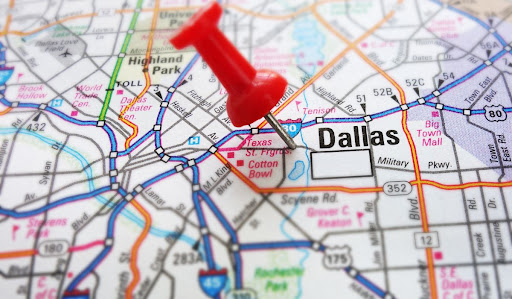Jump Ahead To:
Dallas, Texas, has a little something for everyone, from professional sports to haute cuisine. If you’re thinking of making the move, it’s only natural to wonder about your transportation options. Not everyone has their own vehicle, so it’s helpful to know if a city has reliable public transportation or safe biking options. Although the city’s public transportation system isn’t quite as robust as the ones you’d find in New York or Atlanta, it helps millions of passengers get around the Metroplex.
How Walkable Is Dallas?
Although Dallas has a low Transit Score, it’s considered “very walkable,” earning a Walk Score of 74. This score indicates that people can accomplish most of their errands on foot. It may be easy to walk around, but it’s not necessarily safe. Dallas is known for having a high number of pedestrian accidents each year, prompting City Council members to create a roadmap for eliminating traffic fatalities by 2030. In 2020, 66 pedestrians died while they were trying to get around on foot.

How Bike-Friendly Is Dallas?
Despite having more than 150 miles of bicycle lanes, Dallas isn’t as bike-friendly as it could be. According to the Dallas Morning News, nearly 63% of those lanes are shared with motorists, making them dangerous for cyclists. That said, Dallas does have a Greenbelt, a system of connected trails designed to give residents an alternative to automobile transportation. These trails connect local parks and neighborhoods, making it easier for community members to move around.
At one point, Dallas had a bike-share system with more than 18,000 bikes available for use. Unfortunately, the program caused more problems than it solved. For example, residents routinely called the city’s 311 helpline with complaints about abandoned bikes blocking sidewalks. As a result, Dallas City Council passed an ordinance requiring all bike-share companies to purchase an $808 permit, pay an additional $21 for every bike they owned and take responsibility for responding to bike-related 311 complaints. Rather than pay these fees, most of the bike companies pulled out of Dallas, reducing the fleet of 18,000 to just 3,500.
BikeDFW, a registered nonprofit organization, is working to make cycling safer and more accessible for the city’s residents. In addition to offering bicycle safety courses, the organization works closely with local officials to make bicycle-friendly infrastructure updates and advocate for stronger safety laws.
Car Ownership Rates in Dallas
Nearly 96% of households have access to at least one vehicle, making Dallas one of the most automobile-dependent cities in the United States. According to U.S. Census data, only 2.8% of Dallas County residents use public transportation to commute to and from work. The percentage of residents who commute via bicycle is even lower — 0.2%.
Public Transportation in Dallas
Dallas Area Rapid Transit (DART) operates buses, commuter rail and light rail throughout the Dallas Metroplex, which includes Dallas, Collins, Tarrant and 16 other counties. Dallas County has a population of 2.635 million, so if 2.8% of residents use public transportation to commute to work, that means approximately 74,000 people use DART daily.
DART’s buses and trains operate between 5 a.m. and midnight each day, with trains available every 8 to 15 minutes during rush hour. During non-peak hours, service is available every 20 to 30 minutes. One of the biggest complaints about the DART system is that it takes too long to get around the city. A Reddit user commented, “I always feel the time I save by driving is worth more than the money I save by using the DART.” Another stated that an 8-minute drive to a grocery store turns into a 50-minute trip if he uses DART.
In 2022, DART also faced criticism for some of the updates it made to local bus routes. According to one rider interviewed by the local NBC affiliate, the changes have made it more difficult for people to get around. Instead of taking one bus straight to her destination, she has to use multiple routes, increasing the length of her trip and making it less convenient to use DART for public transportation.
Most Walkable Neighborhoods in Dallas
These are some of the most walkable neighborhoods in Dallas:
- Downtown: The Downtown neighborhood has a Walk Score of 92, indicating that it’s a “walker’s paradise.” If you live downtown, you don’t need a car to run errands, grab a bite to eat or access other local amenities. For example, you can get to an average of 41 restaurants, bars and coffee shops within just 5 minutes. Downtown also has a Transit Score of 85, so if you need to venture beyond the neighborhood’s borders, you can use public transportation rather than paying for a taxi or asking a friend for a ride.
- Henderson: Known as one of the trendiest neighborhoods in Dallas, Henderson has a Walk Score of 87, putting it slightly behind Downtown in terms of walkability. Despite its lower score, Henderson has plenty amenities within walking distance, including nearly 50 restaurants. Henderson’s Transit Score is only 43, however, so you can’t get to many places without switching routes at some point.
- Oak Lawn: If you’re looking for an upscale community with plenty of bars and nightclubs, check out Oak Lawn. This neighborhood has a Walk Score of 85, making it the third most walkable neighborhood in the city. Like Downtown, Oak Lawn has more than 400 restaurants, bars and coffee shops. On average, 11 of those establishments are just a 5-minute walk from wherever you are. Oak Lawn also has more than 14 bus routes passing through it, giving it a Transit Score of 60.
Plan Your Dallas Move with Ease
Although the DART system could use a little work, Dallas is still an exciting city with plenty to see and do. If you decide to make the move, Bellhop is here to help. We have transparent pricing and trustworthy movers in Dallas, making it easy to move across town or across the country.
Other Dallas Guides
- Most Walkable Neighborhoods in Richmond - May 21, 2024
- Best Schools in Omaha, Nebraska: A Comprehensive Guide - May 9, 2024
- The Best Schools in Tucson, Arizona - April 5, 2024



